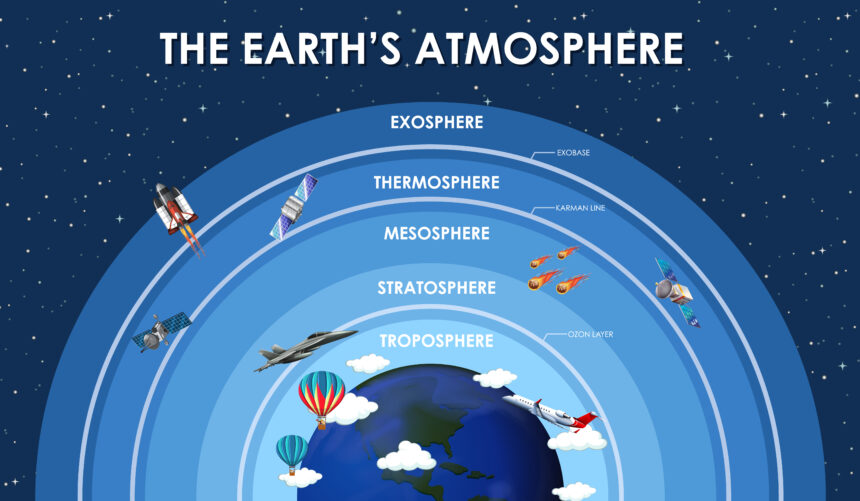Introduction:
Our planet breathes, and its breath is the atmosphere, a vital blanket shielding us from the harshness of space. But this protective shield isn’t uniform; it’s layered, each zone with its unique personality. Buckle up, because we’re embarking on a captivating exploration of the layers of the atmosphere, peeling back the invisible veil to reveal Earth’s hidden wonders.
Layers of the Atmosphere:
Before we launch into the celestial unknown, let’s establish some ground rules. We’ll primarily focus on the five major layers of the atmosphere, identified by their temperature variations:
- Troposphere: Our cozy home, where weather reigns supreme.
- Stratosphere: The ozone haven, guarding us from ultraviolet radiation.
- Mesosphere: Where meteors meet their fiery demise.
- Thermosphere: The realm of scorching temperatures and auroras.
- Exosphere: The fringes of our atmosphere, blurring into space.
Remember our keyword throughout this journey: layers of the atmosphere. Now, let’s take a detailed look at each layer, unraveling its secrets and appreciating its significance.
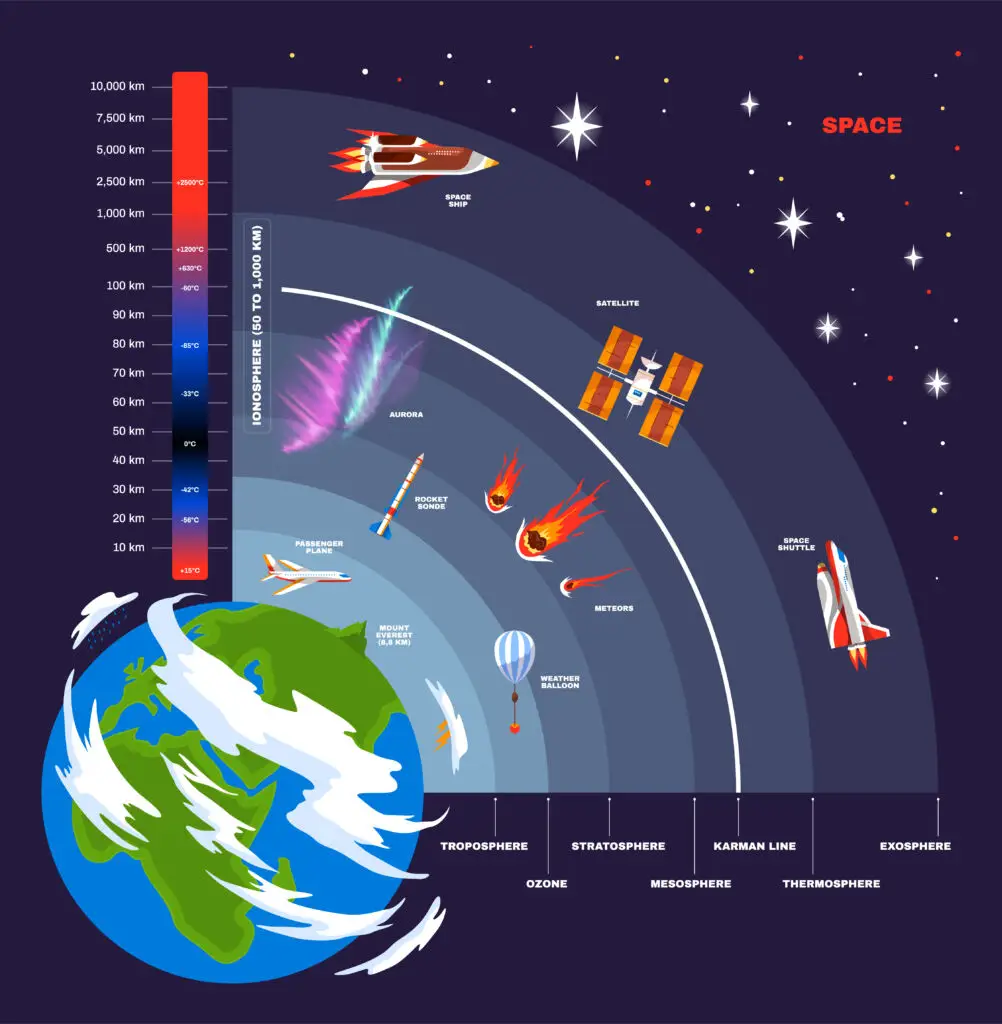
1. Troposphere: The Bustling Biosphere (0-12 km):
Imagine the Earth as a vibrant, teeming city. The troposphere is its bustling downtown, the layer closest to the surface, where 99% of the atmosphere’s mass resides. This is where weather, that ever-changing maestro, conducts its grand symphony. Clouds billow and dance, winds whip and whisper, and precipitation paints the landscape in a palette of rain, snow, and hail. It’s a dynamic realm, constantly churning and evolving, driven by the sun’s energy and the Earth’s rotation.
● Key characteristics:
Temperature: Decreases with altitude (about 6.4°C per 1 km), creating a vertical temperature gradient that drives weather phenomena like convection, cloud formation, and precipitation. This gradient is why it gets colder as you climb a mountain!
Composition: 78% nitrogen, 21% oxygen, and trace gases like water vapor and carbon dioxide compose the atmosphere. This mix is essential for life processes: oxygen for breathing, nitrogen for plant growth, and water vapor for cloud formation and precipitation.
Life’s Playground: Home to all living things, from towering redwoods scraping the troposphere’s ceiling to microscopic plankton thriving in the ocean depths. It’s where ecosystems flourish, food webs intertwine, and the cycle of life unfolds in its magnificent complexity. From soaring birds to majestic whales, the troposphere teems with diverse life forms adapted to its unique conditions.

Weather Phenomena: The birthplace of all weather phenomena we experience – from gentle breezes to raging storms. Convection currents transport heat and moisture, leading to cloud formation, precipitation, and wind patterns. From fluffy cumulus clouds to towering thunderstorms, the troposphere is a dynamic theater where weather unfolds its ever-changing spectacle.
Anthropogenic Activities: While essential for life, human activities like burning fossil fuels and deforestation are impacting the troposphere. These activities release greenhouse gases, contributing to climate change and altering weather patterns. Understanding the troposphere is crucial for addressing these challenges and ensuring a sustainable future for our planet.
2. Stratosphere: The Ozone Guardian (12-50 km):
As we ascend, the air thins and temperatures take an unexpected turn – they start increasing! This is the stratosphere, where the sun’s ultraviolet (UV) radiation works its magic. Here, it interacts with oxygen molecules, splitting them to form ozone (O3), a molecule crucial to our very existence. This ozone layer acts as an invisible shield, absorbing harmful UV rays that would otherwise wreak havoc on life, causing sunburn, mutations, and hindering ecosystem health.
● Key characteristics:
Temperature: Increases due to ozone absorption of UV radiation, creating a temperature inversion compared to the troposphere.
Composition: Similar to the troposphere, but with much less water vapor, crucial for ozone formation.
Ozone Layer: The ozone layer, responsible for shielding us from harmful UV radiation, is the defining feature of the stratosphere. It’s a testament to the delicate balance of the atmosphere, where a single chemical reaction safeguards the planet’s biosphere.
UV Rays’ Protection Cover: The sun, our life-giving star, also packs a punch in the form of ultraviolet (UV) radiation. While some UV rays are beneficial for vitamin D production, others, particularly UV-B and UV-C, can wreak havoc on living organisms, causing sunburn, DNA damage, and even skin cancer.
This is where the stratosphere steps in, armed with its secret weapon – ozone. Formed when UV radiation interacts with oxygen molecules, ozone acts as a protective shield, absorbing harmful UV-B and UV-C rays before they reach the Earth’s surface. It’s like an invisible sunscreen protecting all life below.
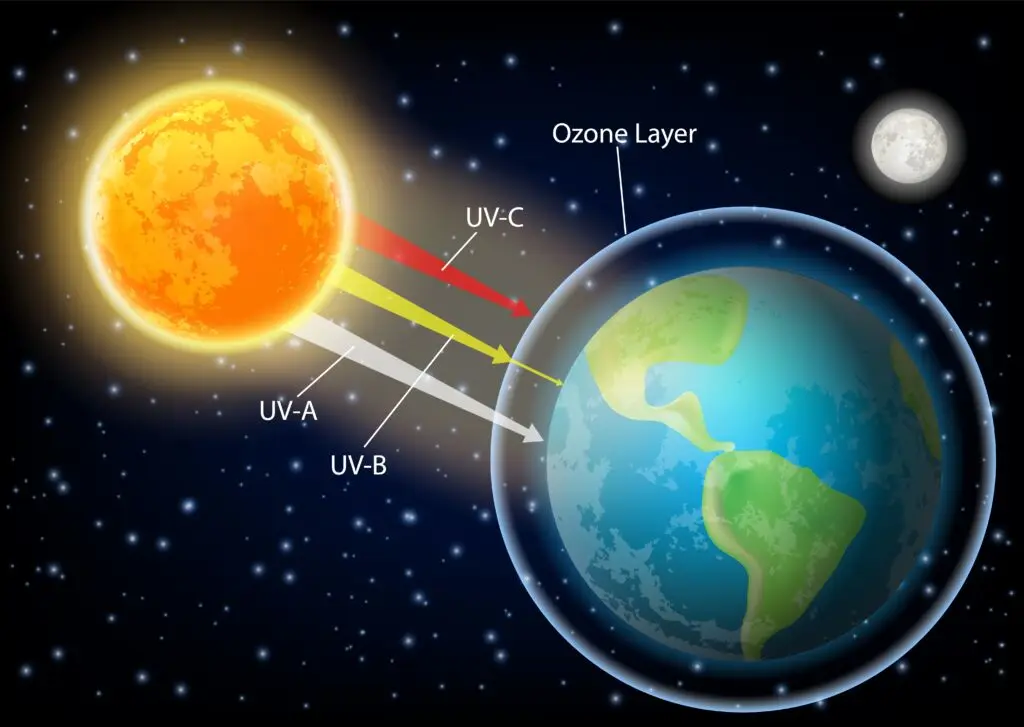
● Beyond its Protective Duties:
The stratosphere isn’t just a passive shield; it’s a dynamic layer with its unique features:
- Temperature inversion: Unlike the troposphere, temperatures increase with altitude due to ozone absorption of UV radiation, creating a unique temperature profile.
Thinning air: As we climb higher, the air molecules become increasingly sparse, making it feel like breathing at high altitudes.
Jet streams: Powerful, fast-moving air currents meander through the stratosphere, shaping weather patterns below the troposphere.
● Threats to the Guardian:
Unfortunately, human activities like the use of certain chemicals have caused ozone layer depletion, creating “holes.” This Ozone Hole allows harmful UV radiation to reach the Earth’s surface, triggering the greenhouse effect, ultimately resulting in global warming.
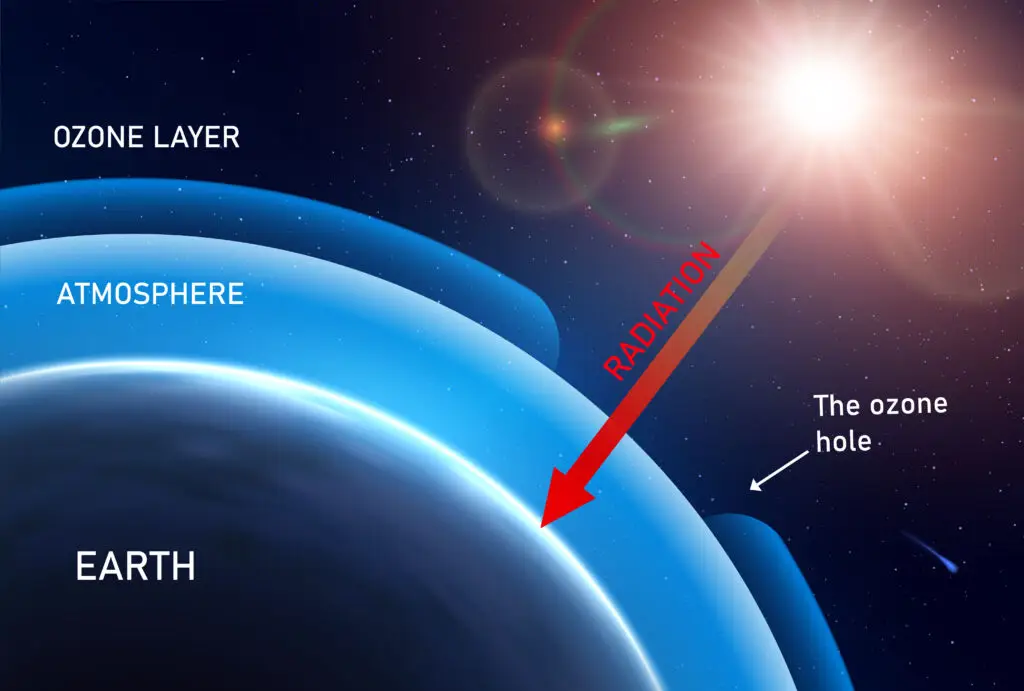
Thankfully, international efforts to protect the ozone layer are showing positive results, reminding us of the importance of understanding and safeguarding this vital atmospheric layer.
So, the next time you bask in the warm sun, remember the silent guardian high above – the stratosphere and its champion, ozone, tirelessly protecting life on Earth from the sun’s harsher rays.
3. Mesosphere: The Meteoric Maelstrom (50-85 km):
Leaving the stratospheric haven behind, we enter the mesosphere, the coldest layer of the atmosphere. Temperatures here plunge to a bone-chilling -90°C, making it the deep freeze of the atmosphere. But amidst this frigid realm unfolds a mesmerizing celestial ballet – the fiery demise of meteors.
These celestial visitors, streaking across the night sky as shooting stars, meet their fiery end in the mesosphere. Due to the thin air and their high speeds, they disintegrate into glowing streaks of light, creating the breathtaking displays we know and love.
● Key characteristics:
Temperature: Plummets with altitude, reaching its coldest point in the atmosphere, making it a region of extremes. Imagine venturing out on a winter night without a coat – that’s the kind of bone-chilling experience you’d encounter here!
Composition: Similar to the stratosphere, but even less dense, with air molecules becoming increasingly sparse. Think of it like trying to breathe on top of Mount Everest – there’s just not enough air to go around.
Fiery Farewell: Meteors, burning at speeds of up to 72,000 kilometers per hour, encounter this thin air, creating friction that heats them to thousands of degrees. This intense heat causes them to vaporize, leaving behind the glowing trails we know as shooting stars. It’s like watching a miniature fireworks display high above!
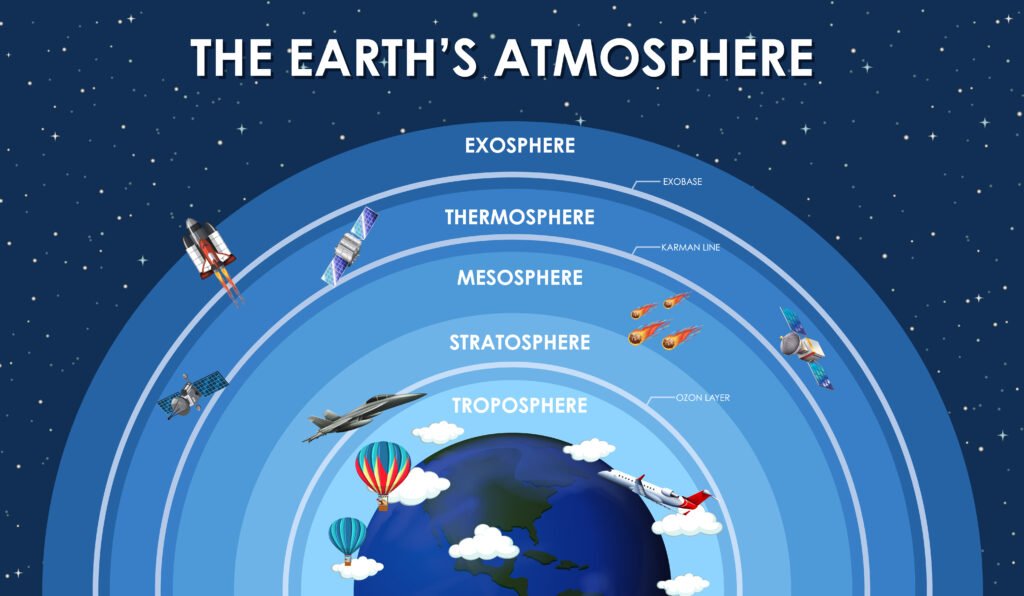
● Beyond the Fiery Curtain:
The mesosphere isn’t just about meteoric mayhem. This layer also plays a crucial role in regulating Earth’s temperature. As the sun’s heat reaches the mesosphere, it’s absorbed by molecules like sodium and potassium, which then emit infrared radiation back toward Earth. This infrared radiation helps warm the lower atmosphere, contributing to the delicate balance that keeps our planet habitable.
But the mesosphere also faces threats. As human activities like space travel increase, concerns grow about the potential impact on this fragile layer. Collisions with satellites and space debris could disrupt the delicate balance of the mesosphere, potentially affecting Earth’s temperature regulation. Understanding this layer is crucial not only for appreciating its beauty and role in celestial displays but also for safeguarding its vital functions for the future of our planet.
So, the next time you gaze upwards and witness a shooting star streaking across the night sky, remember: it’s not just a fleeting moment of beauty, but a testament to the dynamic and vital mesosphere, the coldest layer of the atmosphere.

4. Thermosphere: The Scorching Stage (85-600 km)
Buckle up, adventurers! We’ve left the frigid mesosphere behind and are hurtling towards the thermosphere, the hottest and thinnest layer of the atmosphere. Imagine climbing the world’s tallest mountain, but instead of air thinning and temperatures dropping, things get scorching hot here! Brace yourselves for a fiery exploration of this unique zone in Earth’s protective shield.
As we leave the mesosphere behind and ascend beyond 85 km, the air thins dramatically, becoming a near-vacuum. However, don’t let the lack of density fool you; the thermosphere experiences extreme temperatures due to the direct absorption of the sun’s ultraviolet and X-ray radiation. While the air might be thin, it can reach a staggering 2,000°C, hot enough to melt steel!
● Key characteristics:
Temperature: Soars due to direct absorption of solar radiation, making it the hottest layer of the atmosphere.
Composition: Mainly atomic oxygen and nitrogen, with air molecules becoming increasingly scarce as we climb higher.
Dazzling Displays: Home to the mesmerizing auroras borealis and australis, dancing curtains of light caused by solar particles interacting with the atmosphere. These stunning natural light shows are a breathtaking reminder of the dynamic nature of the layers of the atmosphere.
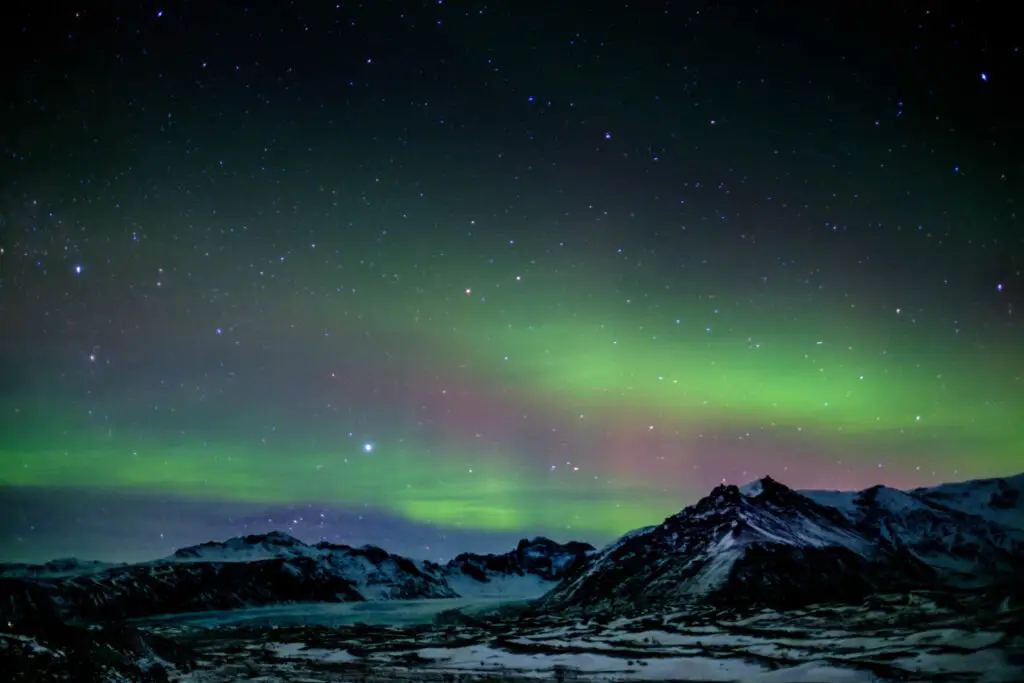
● The Heat is On:
Forget cozy sweaters – in the thermosphere, you’d need fireproof suits! This layer, stretching from 85 to 600 kilometers above Earth, experiences staggering temperatures reaching a mind-boggling 2,000°C. How’s that possible?
Unlike the lower layers warmed by air molecules colliding, the thermosphere is nearly a vacuum. It’s the direct absorption of the sun’s ultraviolet and X-ray radiation that heats things, making it the hottest layer of the atmosphere. Talk about a different kind of sunburn!
● Thin Air, Big Wonders:
While the air density in the thermosphere is incredibly low, near a vacuum, it still holds fascinating surprises. The main players here are atomic oxygen and nitrogen, remnants of molecules broken apart by the sun’s intense radiation. But the real spectacle unfolds when charged particles from the sun, called solar wind, interact with these atoms.
This interaction creates the mesmerizing auroras borealis and australis, those dancing curtains of light that paint the night sky in vibrant hues. It’s a breathtaking reminder of the dynamic nature of the layers of the atmosphere, showcasing how even the thinnest layers can produce awe-inspiring phenomena.
● More Than Just Heat and Light:
The thermosphere plays a crucial role in protecting Earth from the sun’s harmful radiation. It acts as a barrier, absorbing much of the X-rays and ultraviolet radiation that would otherwise damage life on Earth. Additionally, satellites orbiting Earth, vital for communication and navigation, reside in the thermosphere. Understanding this layer of the atmosphere is crucial for predicting their orbits and protecting them from space debris.
But the thermosphere faces challenges. Human activities like space travel can introduce debris into this delicate layer, potentially impacting satellites and disrupting the natural processes that occur here. Studying and protecting the thermosphere is essential for ensuring the continued health of our planet’s atmospheric layers and the wonders they hold.
So, the next time you gaze up at the stars, remember the thermosphere, the hottest and thinnest layer of the atmosphere. It’s a realm of extremes, where sunsets get spicy, auroras dance, and space exploration takes flight. By understanding this unique layer of the atmosphere, we can appreciate its vital role in protecting our planet and ensure it continues to support life and inspire awe for generations to come.
5. Exosphere: The Fringes of Reality (600 km and beyond):
We’ve reached the final frontier—the exosphere. Here, the atmosphere thins to near-nothingness, seamlessly merging with space’s vast emptiness. The air particles are so sparse that they no longer behave like traditional gases, existing in a state of perpetual escape. It’s the edge of our atmosphere, where satellites dance and spacecraft hurtle towards the unknown, marking the boundary between Earth’s protective shield and the cosmic expanse.
● Key characteristics:
Temperature: Highly variable depending on solar activity, showcasing the dynamic nature of the outermost layers of the atmosphere.
Composition: Very thin and diffuse, primarily hydrogen and helium, the lightest elements that can escape Earth’s gravity.
Ionosphere: Not a Layer, But a Region of Charged Wonder
While we’ve explored the distinct layers of the atmosphere, there’s another fascinating region worth mentioning: the ionosphere. Unlike the troposphere or thermosphere, the ionosphere isn’t a distinct layer. Instead, it’s a dynamic zone spanning parts of the mesosphere and thermosphere where magic happens – atoms and molecules get charged!

- High-energy radiation: The sun throws punches in the form of powerful ultraviolet and X-ray radiation.
- Knockout effect: This radiation hits atoms and molecules in the mesosphere and thermosphere, knocking electrons loose from their usual positions.
- A sea of charged particles: These “freed” electrons create a region of charged particles, also known as ions, hence the name “ionosphere.”
● Key characteristics:
Location: Not a distinct layer, but spans parts of the mesosphere and thermosphere (80-600 km).
Creation: Formed by high-energy solar radiation ionizing atoms and molecules.
Composition: A mix of neutral and charged particles, dominated by ions and free electrons.
Dynamic nature: Constantly changes depending on solar activity and Earth’s magnetic field.
● Why is the ionosphere important?
- High-energy radiation: The sun throws punches in the form of powerful ultraviolet and X-ray radiation.
- Protecting us: Absorbs some harmful solar radiation, shielding Earth’s inhabitants.
- Creating beautiful displays: The charged particles interact with Earth’s magnetic field, causing the mesmerizing auroras Borealis and Australis.
Remember: the ionosphere is a region within the layers of the atmosphere, not a distinct layer itself. It’s a reminder that the atmosphere is a complex and dynamic system, with fascinating phenomena unfolding beyond the neatly defined layers.
Conclusion
Our exploration of the layers of the atmosphere has revealed a captivating story of protection, dynamism, and beauty. From the bustling biosphere of the troposphere to the scorching realm of the thermosphere and the ethereal fringes of the exosphere, each layer plays a crucial role in sustaining life, regulating temperature, and shielding us from harmful radiation.

Understanding these layers is vital for appreciating the delicate balance of our planet and predicting the impacts of human activities on its vital systems. As we continue to explore and research the atmosphere, we gain a deeper appreciation for the remarkable invisible shield that protects and sustains our fragile blue marble.
But the questions linger:
- How might human activities like climate change disrupt this intricate atmospheric choreography?
- Can we harness the wonders of the ionosphere for sustainable communication and exploration?
- What mysteries still lurk in the unexplored fringes of the exosphere?
Remember, the layers of the atmosphere are not static entities; they are constantly interacting, exchanging energy, and responding to the sun’s influence. By understanding these interactions, we can better understand our planet’s climate, weather patterns, and the delicate balance that makes life on Earth possible.
So, what will your next step be in unraveling the wonders of the atmosphere? Will you delve deeper into specific layers, advocate for its protection, or inspire others to appreciate its beauty?
The choice is yours, fellow explorers. Let the atmospheric symphony continue to play, and let curiosity guide your journey toward a future where we understand and cherish this remarkable shield that protects our fragile blue marble.

